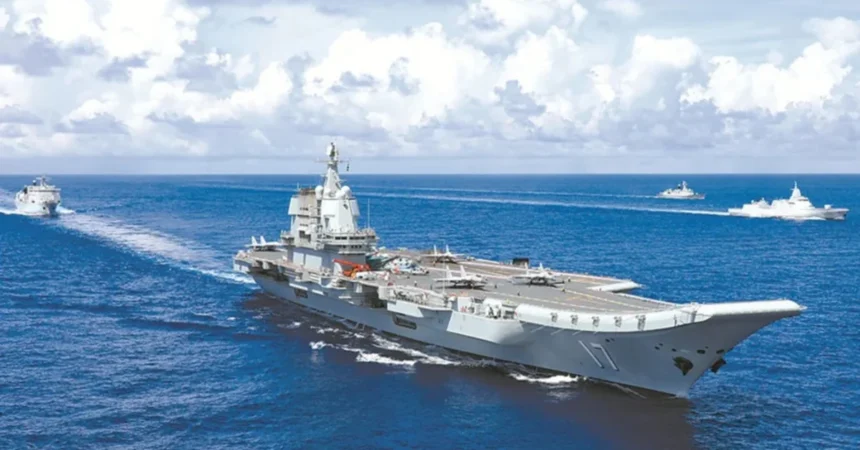In a significant show of military strength, a Chinese aircraft carrier group has recently sailed through the Taiwan Strait, prompting heightened concerns among regional observers. This maneuver is part of an ongoing series of military exercises by China, coinciding with the passage of U.S. and Canadian warships through the same strategic waters. The situation reflects the increasing tensions in the region as Beijing asserts its influence over Taiwan, a territory it views as a breakaway province.
Context of the Taiwan Strait
The Taiwan Strait, which separates the island of Taiwan from mainland China, has historically been a flashpoint in Sino-American relations. Since the end of the Chinese Civil War in 1949, when the Nationalist government retreated to Taiwan after being defeated by the Communist forces of Mao Zedong, the two sides have remained politically and militarily distinct. Despite Taiwan’s independent government, military, and currency, Beijing insists that the island is part of its territory and has not ruled out the use of force to achieve reunification.
Recent Military Developments
Taiwan’s defense ministry reported on Wednesday that it had detected 15 Chinese military aircraft and six naval vessels operating around the island within a 24-hour period leading up to the morning update. This increased military activity from China has raised alarms in Taipei, which has accused Beijing of escalating intimidation tactics in the region.
Live-Fire Drills
Over the weekend, China conducted live-fire military drills near Taiwan, which Taipei interpreted as a demonstration of force. Officials in Taiwan characterized these exercises as part of Beijing’s broader strategy to intimidate the island. The live-fire drills come amidst reports of the Chinese carrier group’s presence in the strait, amplifying fears of a potential military confrontation.
U.S. and Allied Naval Operations
In a display of solidarity and commitment to regional stability, a U.S. Navy warship and a Canadian vessel passed through the Taiwan Strait just days before the Chinese military exercises. Such naval operations are routine for Washington and its allies, designed to reinforce the notion that the strait is an international waterway. However, these passages have been met with strong condemnation from Beijing, which claims they disrupt the peace and stability of the region.
China’s foreign ministry expressed outrage over the allied naval passage, asserting that it poses a threat to the security of the strait. This reaction underscores the delicate balance of power and the competing interests of regional players, particularly the United States, which maintains a policy of strategic ambiguity regarding its defense commitments to Taiwan.
The Implications of Increased Military Activity
The navigation of the Chinese aircraft carrier group through the Taiwan Strait signals a potential escalation in military posturing. Analysts have noted that such movements are not merely logistical but are intended to project strength and assert China’s territorial claims. The presence of the carrier group in these contested waters raises significant concerns regarding the potential for miscalculations or confrontations.
Strategic Importance of the Taiwan Strait
The Taiwan Strait is not only a vital route for maritime trade but also holds strategic military importance. Control over this waterway is critical for both China and Taiwan, influencing the balance of power in East Asia. The strait serves as a conduit for military logistics, making it a focal point in any potential conflict scenario.
The increasing presence of Chinese military assets in the region has prompted Taiwan to enhance its own defensive capabilities. The Taiwanese government has been vocal about its commitment to maintaining its sovereignty and has called for greater vigilance in the face of escalating Chinese military threats.
Responses from Taiwan
Taiwan’s government has reacted firmly to the heightened military activity from China. Officials have reiterated their commitment to defend the island’s sovereignty and democratic way of life. The Taiwanese military has been conducting its own exercises to prepare for any potential conflict, ensuring that its forces are ready to respond to any aggressive actions from Beijing.
Strengthening Defense Capabilities
Taiwan has invested significantly in modernizing its military forces in recent years. This includes acquiring advanced weaponry and enhancing its air defense systems. The government has also focused on developing asymmetric warfare capabilities to counter the numerical superiority of the Chinese military.
The Taiwanese leadership has called for international support to bolster its defense efforts. In light of the increasing military provocations from China, Taiwan seeks to strengthen its alliances with countries that share its commitment to democratic values and regional stability.
Regional Reactions to the Tensions
The military activities in the Taiwan Strait have drawn international attention and concern. Many regional powers are closely monitoring the situation, given the potential ramifications for security in East Asia.
The Role of the United States
The United States has played a crucial role in the Taiwan Strait dynamics. Washington’s commitment to Taiwan, enshrined in the Taiwan Relations Act, involves providing defensive support to the island. The U.S. has emphasized its stance against any unilateral changes to the status quo in the Taiwan Strait.
In recent years, the U.S. has increased its military presence in the region, conducting freedom of navigation operations and enhancing partnerships with allies. These actions are seen as a counterbalance to China’s growing assertiveness and a reaffirmation of the U.S. commitment to maintaining a free and open Indo-Pacific.
Alliances in the Region
Other nations in the region, such as Japan and Australia, have expressed support for Taiwan and have increased their military cooperation with the U.S. The trilateral security arrangements and joint exercises involving these nations reflect a collective commitment to addressing security challenges posed by China’s military expansion.
The Taiwan-China Relationship
The relationship between Taiwan and China remains fraught with complexity. Despite ongoing tensions, there are economic ties that bind the two sides. China is Taiwan’s largest trading partner, and many Taiwanese businesses operate in mainland China. However, these economic interactions are overshadowed by the political realities and military threats posed by Beijing.
The Stance of the Taiwanese Leadership
The current Taiwanese administration, led by President Tsai Ing-wen, has adopted a firm stance against Beijing’s pressure. Tsai has advocated for a distinct Taiwanese identity and has emphasized the importance of maintaining the island’s democratic governance. Her administration has resisted calls for unification under Beijing’s terms, which many in Taiwan view as a threat to their freedoms.
Global Perspectives on the Situation
The international community has been closely watching the developments in the Taiwan Strait. Many countries have expressed concern over China’s assertive actions and the implications for regional stability. Diplomatic efforts to address tensions have been made, but the complexity of the situation poses significant challenges.
The Role of International Organizations
Organizations such as the United Nations have been largely ineffective in addressing the Taiwan issue, primarily due to the political sensitivities surrounding China’s claims. Taiwan’s participation in international forums remains limited, despite its desire to engage with the global community. The lack of recognition as a sovereign state complicates efforts to garner international support.
Future Prospects
The ongoing military activities in the Taiwan Strait signal a precarious situation that requires careful management. The risk of miscalculations leading to a conflict remains a significant concern for all parties involved. As tensions continue to rise, diplomatic efforts will be crucial in navigating the complexities of the relationship between Taiwan and China.
The Need for Dialogue
Engaging in constructive dialogue between Taiwan and China could provide a pathway to reducing tensions. However, both sides must be willing to come to the negotiating table and seek common ground. The challenge lies in addressing the fundamental differences in political ideologies and national identities.
The recent maneuvers by the Chinese aircraft carrier group through the Taiwan Strait, combined with the heightened military activity from both sides, underscore the fragile state of affairs in the region. As Taiwan continues to assert its sovereignty and defend its democratic values, the involvement of external powers, such as the United States and its allies, adds complexity to an already tense situation.
The situation demands ongoing vigilance and a commitment to dialogue to prevent escalation into open conflict. The international community’s role will be pivotal in ensuring stability in the Taiwan Strait, fostering an environment where peace and cooperation can prevail over aggression and intimidation.
#TaiwanStrait #China #Taiwan #MilitaryTensions #USNavy #RegionalSecurity #InternationalRelations #AsiaPacific







